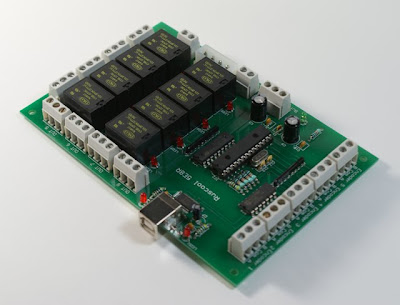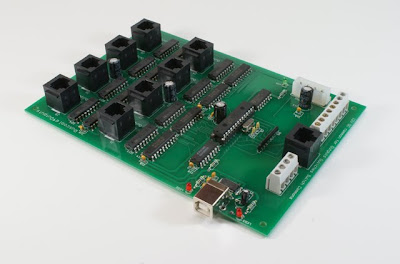Following is a list of our current products, along with a brief description. Our site contains much more in-depth information about each item, including diagrams, hardware specifications, and software configuration details. Direct links to each product can be found below.
AUTOPILOT (AP5E5D)
 This USB connected unit has one 4-digit with + sign, one 5-digit and three 3-digit 7-segment LED displays to emulate the autopilot displays of a typical airliner.
This USB connected unit has one 4-digit with + sign, one 5-digit and three 3-digit 7-segment LED displays to emulate the autopilot displays of a typical airliner.5 rotary encoder inputs allow the setting of Course, Airspeed, Heading, Altitude, and Vertical Speed. 2 inputs are pre-configured for the Autopilot and Autothrottle switches. No user configuration is required.
This photo shows a typical configuration complete with the mechanical rotary encoders and the toggle switches that are supplied as part of this unit. The acrylic faceplate (with milled cut-outs and smoky grey faces for the displays) is also supplied. The dimensions of this faceplate are 390mm x 65mm x 10mm.
Click here for further details.
ENCODERS and OUTPUTS (5E8R)
This USB connected board can accept 5 rotary encoders and 2 switches as inputs, and has 8 relays as outputs.
The supplied software allows the user to first set up the inputs and outputs as they desire in the configuration program, and then when the main program is run, all of the rotary encoders and switches will directly control Flight Simulator. The relays will respond to Flight Simulator conditions so that LEDs, Lamps, Solenoids, etc can be turned on and off appropriately. Instructions and full connection details are included.
Click here for further details.
The supplied software allows the user to first set up the inputs and outputs as they desire in the configuration program, and then when the main program is run, all of the rotary encoders and switches will directly control Flight Simulator. The relays will respond to Flight Simulator conditions so that LEDs, Lamps, Solenoids, etc can be turned on and off appropriately. Instructions and full connection details are included.
Click here for further details.
64 INPUTS (64INS)
This USB connected board can accept 64 switch inputs. The supplied software allows the user to configure the inputs and then, when the main program is run, all of the switches will directly control actions within Flight Simulator. The switches are arranged in blocks of 8 utilising readily available RJ45 plugs and cables. Instructions with full connection details are included. The inputs are designed for pushbuttons and toggle switches (or any combination thereof), and even multi-position switches. They are not suitable for rotary encoders.
Click here for further details.
Click here for further details.
64 OUTPUTS (64OUTS)
This USB connected board has 64 outputs which respond to Flight Simulator parameters. A comprehensive but simple to use configuration program allows an output to be controlled from virtually any FSUIPC offset value. Each output can control LEDs, Lamps, Relays, Solenoids, etc.
Click here for further details.
Click here for further details.
This USB connected unit has two 5-digit 7segment LED displays to enable a wide range of radio configurations. Com1&2 and Standby, Nav1&2 and Standby, ADF1&2, and Transponder are available. Active/Standby with Transfer Button is configurable also. 5 Rotary Encoder inputs allow four to be used with the radios, and the fifth to be used with any other applicable function (e.g. for setting the QNH). A comprehensive but simple to use configuration program is supplied.
Click here for further details.
Click here for further details.
COCKPIT INTERCOM (RAI-2)
 A full implementation of this intercom allows the Pilot and First Officer to communicate with each other, and also with an Instructor. A sidetone volume control on the board allows for the setting of how loud you hear yourself speak. The unit will accept an Electret or a Dynamic microphone and with stereo headphones, will accept stereo input from the PC so that you can hear engine sounds with more realism because sounds are heard coming from the correct direction. (The intercom can be supplied in a mono configuration if desired.) Inputs allow a Push To Talk button to be used, or a toggle switch will allow an open microphone configuration.
A full implementation of this intercom allows the Pilot and First Officer to communicate with each other, and also with an Instructor. A sidetone volume control on the board allows for the setting of how loud you hear yourself speak. The unit will accept an Electret or a Dynamic microphone and with stereo headphones, will accept stereo input from the PC so that you can hear engine sounds with more realism because sounds are heard coming from the correct direction. (The intercom can be supplied in a mono configuration if desired.) Inputs allow a Push To Talk button to be used, or a toggle switch will allow an open microphone configuration. Click here for further information.






Looks very good. Some nice clean boards to connect onto.I am currently building a 737 thottle for my home cockpit. I am still working on the external parts and I am having to design them myself, so it is taking some time. After that I will be switching to the electronics. Best of luck with your sim. It is looking very good.
ReplyDelete